1
Saga of 10BP ...When Melville Culbert was unable to continue broadcasting from Dungannon, W.T. "Doc" Cruickshank took over the amateur license and call letters for 10BP. Under the license terms he could use up to 10 watts of power and broadcast from the frequency of 1200 cycles. He was not allowed to sell airtime for advertising or seek sponsors for his programming. He was one of many radio enthusiasts in Canada, tinkering with the new technology and experimenting with its abilities and properties. As a radio store owner, Cruickshank found there was little programming for radio buyers to listen to, once they'd bought a new-fangled radio. So with a limited range of broadcasting power, Cruickshank turned to his home community - Wingham and began producing programs they could easily get in on their radio sets.
Wingham ...
Bud Cruickshank (Doc's son) once described Wingham as "a place where you can walk to work in two minutes. But it might take you half an hour or more to walk a block on the main drag. Everyone knows everyone else and maybe even their business. Such is the quality and intimacy of life in Wingham, an unhurried farm town of 3,000 high on the arch of the southern Ontario "boot." (LFP-5, 1970) Eventually through CKNX, Wingham was to became a household name. But in the beginning, the radio broadcast focused on the town; broadcasting local news bulletins, a weekly church service for shut-ins, commentary on Wingham baseball & hockey games and music from local performers.
The Call Letters - 10BP ...
The call letters 10BP were assigned not chosen, so had no local or personal significance to Doc Cruickshank. Over time, announcers on 10BP were to find the call letters difficult to pronounce at time and listeners commented on confusion about the station's name. But during the period from 1926 to 1935, it mattered little. 10BP was a hobby. It was an opportunity to explore the unknown realm of radio - and give his radio customers something to listen to. Doc began to find that radio sales from his repair shop were being spurred by his broadcasts so one complimented the other. Actually Doc built only three or four radios himself before aligning with a radio firm as a serviceman but he knew then his broadcasts would spur sales. (LFP-5, 1970)
2
The radio control room of CKNX in 1938.1938
920 CKNX, Wingham, Ontario
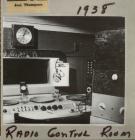 Credits:
Credits:Wingham Library, Wingham, Ontario
Wingham Professional Businesswomen's Association
3
W.T. "Doc" Cruickshank with the radio transmitter he built with a Popular Mechanics articleFebruary 1926
Cruickshank's Radio Shop, Josephine Street, Wingham, Ontario
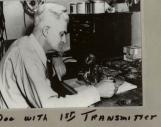 Credits:
Credits:North Huron Museum, Wingham, Ontario
4
Location ... Location ... LocationIn 1929, W.T. Cruickshank moved his Radio Shop and radio station 10BP into the north store of the Shaw Block (197,199,201 Josephine St = Shaw Block, therefore north store is 201 Josephine Street). In this location he had a studio for live broadcasting behind the store, followed by a control room and transmitter. (MM p.159) "The radio shop which also served as a studio was on main street in Wingham, one of the lowest places in town." Somedays, Mr Langridge (a CKNX employee) recalls," the signal just wouldn't travel well and there'd be a call from radio owners saying they couldn't get the signal. Doc would load up the little transmitter and take it up to his house located up on this hill, and start broadcasting again and would be greeted by telephone callers saying that was much better." (50 years, 1976, p.6)
5
Exterior of CKNX on Josephine Street, Wingham - circa 1940s1940s
Original radio station, Josephine Street, Wingham, Ontario
 Credits:
Credits:North Huron Museum
6
StaffAccording to Doc, "I was full-time at the station for a while where I did everything from sweeping to announcing. Then one day I heard a recording of my own voice. I can tell you it was something of a shock! I couldn't believe that I was forcing people to listen to this kind of voice. I said, "That's it,' and I never went on the air again. I turned the job over to my son Bud, who was now old enough to take part in the business. Then my brother John came into it in 1935 and took over some of my duties, including some of the announcing." (Bill McNeil)
In 1930, Cruickshank's staff doubled from one to two, as radio enthusiast George Howson began to help out. (50 years, 1976, p.5)
7
Dr. George Howson helped organize the Wingham Radio Club.1924-1940
Wingham, Ontario
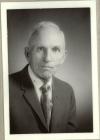 Credits:
Credits:Wingham Library, Wingham, Ontario
Wingham Professional Businesswomen's Association
8
Money, Money, MoneyUp to this point I had been running the station with whatever little bit of money I had to spare out of my own pocket, but eventually I found I had no money at all. There were many times I became so discouraged about the station not bringing in money and taking so much of my time that I'd decide to quit - that today would be the last day of broadcasting. Every time I'd say that, somebody would come along encouraging me to keep it going, and we'd try it again. McNeil, Voice of the Pioneers)
For 4 years CKNX did little but use up Cruickshank's money and time. Because it was an amateur station, they couldn't sell time so there were no advertisers or sponsors. Due financial pinches, the ventures nearly collapsed several times. (CKNX 25th Anniversary 1951)
The Wingham Radio Club's 300 members (all paid a dollar a year for their membership) helped Doc with the radio station's expenses. Write ups from the Wingham Advance-Times indicate that the radio club sponsored 10BP, invested in better equipment, 3 x a week programming of an hour in length and church services on Sundays. Staff doubled from just Doc to Doc and George Howson who helped out. (CKNX 25th Anniversary 1951)
Early officers of the Wingham Radio Club, included the late Dr. A.J. Irwin, J.A. Morton and W.J. Greer. Also Dr. George Howson, who is still practicing dentistry in Wingham, and the late Reg Douglas, who acted as announcers during the early years of operation and Mr. W.A. Galbraith, whose work and advice as Secretary-Treasurer of the Radio Club, meant much to maintain interest in the radio club. (CKNX 25th Anniversary, 1951)
9
Charles Lever's Wingham Radio Club card, 1926-19271 March 1926
10 BP station, Wingham, Ontario
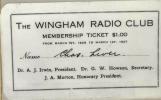 Credits:
Credits:Wingham Library, Wingham, Ontario
Wingham Professional Businesswomen's Association
10
Letter from Wingham Radio Club regarding their wishes to update their equipment1930s
10 BP station, Wingham, Ontario
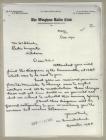 Credits:
Credits:Wingham Library, Wingham, Ontario
Wingham Professional Businesswomen's Association
11
Letter from Wingham Radio Club about updating their equipment in 19311931
10 BP station, Wingham, Ontario
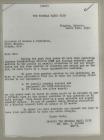 Credits:
Credits:Wingham Library, Wingham, Ontario
12
Early 10BP Programming ...Churches ...
According to Cruickshank in Bill McNeil's book - "On Sunday we always did a service from one of all the churches...
On Sunday, after church service, we had a little program for which I took the transmitter and everything down to my home. I had to do that in order to get a piano. I'd carry the transmitter under my arm down to my home and we'd do an hour broadcast, Sunday afternoon, from down there. There was a program of music-hymns and that sort of thing-with local people along for singing and playing the piano. There was recorded music available but it was of no use to me because I didn't have a turntable to play it on. I only had one microphone, and everything was done through that."
13
Local groups, like these CGIT(Christian Girls In Training) members, performed on CKNX radio1935-1970s
CKNX Television & Radio station, Wingham, Ontario
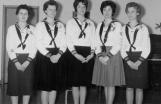 Credits:
Credits:North Huron Museum, Wingham, Ontario
14
Sports ...Thursday nights saw a special program in the early days that featured music, news and often reports on hockey games completed moments earlier. In fact Doc recalled the story once of doing an "on-the-spot" broadcast of a ball game in Teeswater using his car as a studio. During the game an errant drive sent the baseball through the car window and into the makeshift radio (studio)." (VS-1, 1976) (50 years, 1976, p.6)
In the early, early days of 10BP the town of Wingham had some very good baseball teams and in some instances the local talent was supplemented by the use of a couple of imports, usually pitchers and catchers, who were given jobs in local industries to make it worth their while to spend the summer in Wingham. Some of the early radio stations in the US had begun to carry 'play-by-play' commentaries of games, and Doc decided to try it as well. Some of the stories about Doc and the station are legend, and like most such stories they tended to become embellished over time, especially after the principal in the story has been deceased. However, most locals swear to the veracity of this one. The story goes that Doc was sitting in his car behind home plate at the local ball park, his simple amplifier in the back seat, and a microphone in his hand, doing a play-by-play of the game that was carried back to the station transmitter by telephone line. One of the visiting players was at bat and the commentary is said to be thus: "He hits a towering drive to deep center field - Bill (the outfielder) has turned his back to the plate, and is running to the fence, -- he is circling under it, he haaa, Oh Shit he dropped it." (Carbert essay, 1995) p.6-7